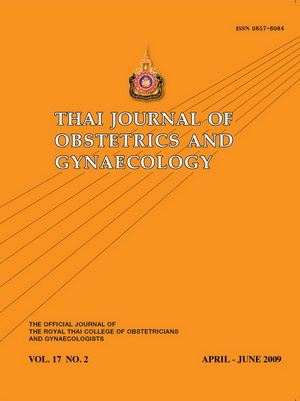Postpartum Glucose Intolerance in Gestational Diabetes Mellitus Women
Main Article Content
Abstract
Objective:
To study the prevalence of and determine antepartum factors for postpartum glucose intolerance in women with gestational diabetes mellitus (GDM).
Materials and Methods:
Medical records of women who had been diagnosed with GDM and underwent 75-gram oral glucose tolerance test (OGTT) at six weeks postpartum in our institution between January 2004 and June 2008 were included. The clinical features of those who had postpartum normoglycemia, and glucose intolerance were compared. Multivariable analysis was used to determine risk factors for postpartum glucose intolerance.
Results:
Of 330 women, 190 (57.6%) had postpartum normoglycemia and 140 (42.4%) had glucose intolerance (28.8% and 13.6% developed impaired glucose tolerance and permanent diabetes respectively). In comparison to women who remained normoglycemic, those who developed postpartum glucose intolerance had significantly higher degree of hyperglycemia (glucose challenge test [GCT] value and plasma glucose levels of OGTT) and GDM classification, and higher rate of insulin use. In a multivariable analysis, higher GCT level (> 200 mg/dl), 1-hour (> 190 mg/dl) and 3-hour plasma glucose of OGTT (> 145 mg/dl) were identified as the antepartum risk factors for postpartum glucose intolerance (3.6-fold; p < 0.001, 5.7-fold; p < 0.001 and 19.4-fold; p < 0.001 respectively).
Conclusion:
The prevalence of postpartum glucose intolerance in the present GDM population was 42.4%. Women with higher GCT level, 1-hour and 3-hour plasma glucose of OGTT are at increased risk of postpartum glucose intolerance.

